Apple iPhone 6s And 6s Plus Review
The iPhone 6s and 6s Plus may look just like last year's iPhones, but hardware updates and Apple's new 3D Touch feature make them feel completely new. While the new cameras and 4K video recording may get the hype, it's the 2GB of RAM that steals the show.
Why you can trust Tom's Hardware
Camera Performance And Photo Quality
It's time to see if the iPhone's new 12 MP iSight camera is an upgrade over the previous generation, or if the smaller pixels are a step backwards. All of the images shown below were taken using the stock camera app's Auto mode unless noted. Also, you can view the full-sized image for each photo by clicking the text links below the images that are within a slideshow album. The LG G4 and Galaxy S6 both use a native 16:9 aspect ratio, although most of the G4's pictures were taken with a 4:3 aspect ratio, which is what all of the iPhones use. This does not impact the quality of the G4's pictures, since it just crops the edges of the frame. Also, our Galaxy S6 uses the Sony Exmor RS IMX240 image sensor, which we've shown to produce better images than the alternate Samsung S5K2P2 ISOCELL sensor.
Outdoors
Daylight








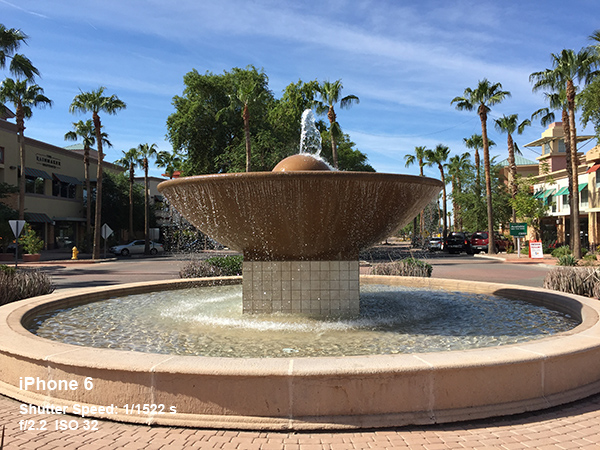
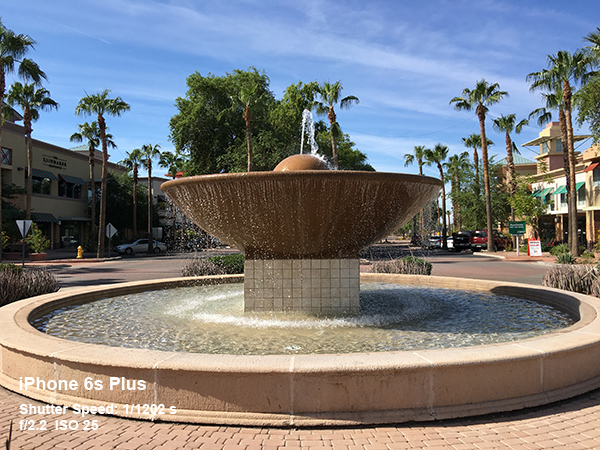



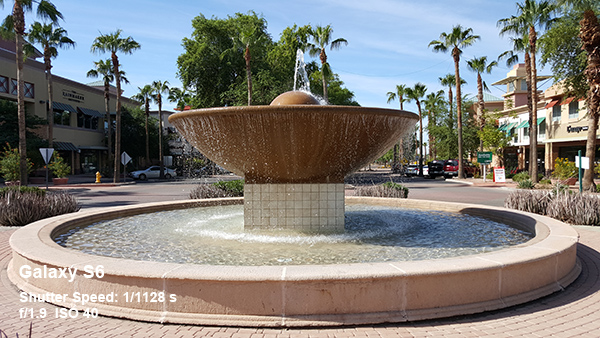
Full-Size Images: [iPhone 6s: daylight island], [iPhone 6: daylight island], [iPhone 6s Plus: daylight island], [iPhone 6 Plus: daylight island], [iPhone 5s: daylight island], [LG G4: daylight island], [Galaxy S6: daylight island], [iPhone 6s: daylight fountain], [iPhone 6: daylight fountain], [iPhone 6s Plus: daylight fountain], [iPhone 6 Plus: daylight fountain], [iPhone 5s: daylight fountain], [LG G4: daylight fountain], [Galaxy S6: daylight fountain]
In our first set of images, taken on a partially overcast day, we see some minor differences between the test images. The 5s uses the fastest shutter speed, resulting in the darkest image overall, with the iPhone 6 and 6s devices using progressively longer exposures, increasing brightness a bit. The 6s phones also have a slightly lower minimum ISO of 25 versus 32 for the previous model. The LG G4 and Samsung Galaxy S6 use the longest exposures, resulting in the brightest images.
Both models of the iPhone 6 and 6s set the white balance correctly, capturing the most natural colors. The 5s, G4, and Galaxy S6 are pretty close, but skew just a little too warm.
The 6s and 6s Plus appear to have more detail than the earlier iPhones, but this is mostly because they do a better job adjusting focus, and because they seem to be using more aggressive edge sharpening, which produces additional aliasing along some edges. The Galaxy S6 image is noticeably sharper and more detailed than any of the iPhone images.
Speaking of sharpness, the right side of the G4's image is noticeably lacking it. We've noticed this in a couple of other images too, where the right side is blurrier than the left. Since this does not happen consistently, it appears to be a side effect of noise reduction processing. There's also some noise reduction artifacts around edges, especially noticeable around the ropes. The iPhone's noise reduction looks better here, producing a smooth-looking sky with no edge artifacts. Compared to the iPhone 6, the 6s produces more noticeable noise grain in the water, the darkest part of the scene. The S6 shows the least amount of noise overall.
Get Tom's Hardware's best news and in-depth reviews, straight to your inbox.
When there's an abundance of sunlight, like in the second set of images with the fountain, differences in image quality are far more subtle, with all phones producing nice pictures. For the most part, our observations from the first set of images also apply here, with the only notable exception being the slightly cooler white balance of the S6 and G4.









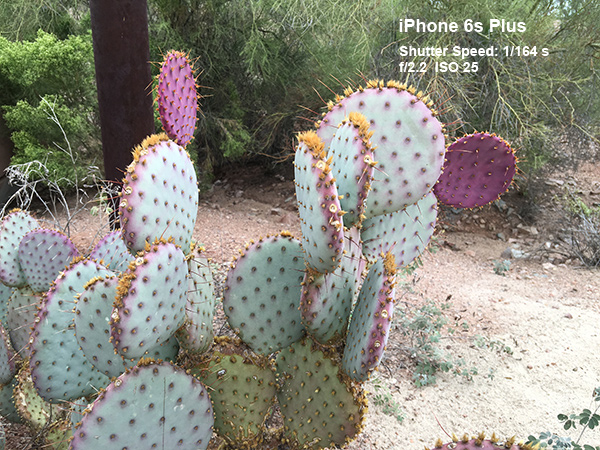




Full-Size Images: [iPhone 6s: daylight flowers], [iPhone 6: daylight flowers], [iPhone 6s Plus: daylight flowers], [iPhone 6 Plus: daylight flowers], [iPhone 5s: daylight flowers], [LG G4: daylight flowers], [Galaxy S6: daylight flowers], [iPhone 6s: daylight cactus], [iPhone 6: daylight cactus], [iPhone 6s Plus: daylight cactus], [iPhone 6 Plus: daylight cactus], [iPhone 5s: daylight cactus], [LG G4: daylight cactus], [Galaxy S6: daylight cactus]
Once again, on an overcast day, the iPhone 5s sets the shortest exposure and captures the darkest image of the yellow flowers. While there's no brightness difference between the iPhone 6 and 6s images, both 6s cameras use a longer exposure again. This seems to be a necessary change to compensate for the lower ISO and the new sensor’s smaller pixels.
Other than the luminance difference, and the fact that the 5s image is a little out of focus, the images from all of the iPhones look very similar. Colors look good and are nicely saturated, however, they all suffer from aggressive noise reduction that blurs edges and adds an unnatural waviness to the out-of-focus background. Overall, the differences between the iPhone 6 and 6s images are subtle. The iPhone 6s' extra pixels improve detail, but it's a little disappointing that we do not see a bigger jump in quality.
In this situation, the Galaxy S6 once again produces the best image. It's bright, with excellent color and detail. Image noise is minimal, and the camera's larger aperture creates a nice bokeh effect. The only issue we see with the S6's image is some color haloing around edges, likely caused by a post-processing sharpening filter. In contrast, the iPhone's sharpening filter appears to only work on the luminance channel, rather than RGB, creating a more subtle light/dark outline.
Depending on personal taste, the LG G4's image could also be judged superior to the iPhone 6s'. Its colors look nice but are not as saturated as the iPhone's. The G4's noise reduction algorithm, which works progressively better with less available light, does a better job than the iPhone's. What really sets the G4's image apart from the others, though, is its limited depth of field, a product of having the largest aperture of any current smartphone. Only the yellow flowers in the foreground are in focus, with the rest of the image mostly blurry. While the G4's limited depth of field works to its advantage in the closeup of the flowers, the bokeh effect is not always desirable; it cannot keep the entire cactus in focus, for example.
In the cactus pictures, the iPhone 6s cameras exhibit better dynamic range as compared to the earlier iPhone models. The greater difference between highlights and shadows gives the images better overall contrast. Colors in all of the iPhone images look a bit too saturated, although we find this preferable to the dull and lifeless G4 image. Even though the Galaxy S6 captures more detail than the iPhones, the iPhone images look sharper from a distance because of their more aggressive sharpening filter.
Afternoon










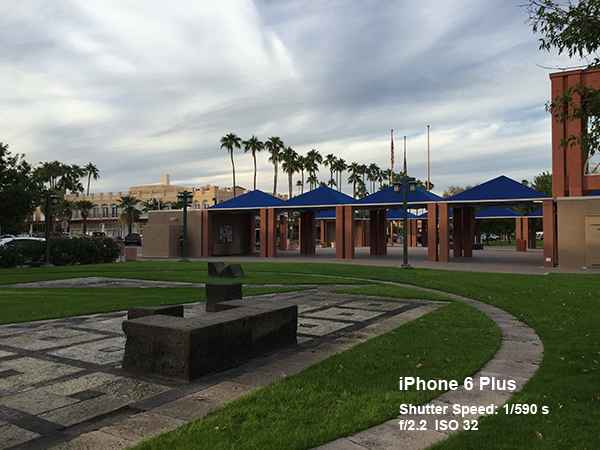
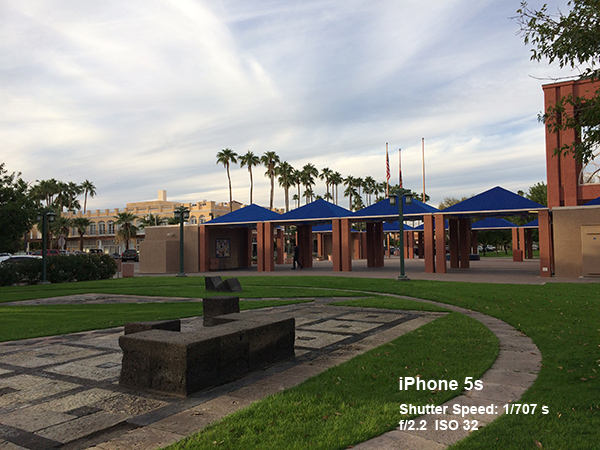


Full-Size Images: [iPhone 6s: afternoon giraffes], [iPhone 6: afternoon giraffes], [iPhone 6s Plus: afternoon giraffes], [iPhone 6 Plus: afternoon giraffes], [iPhone 5s: afternoon giraffes], [LG G4: afternoon giraffes], [Galaxy S6: afternoon giraffes], [iPhone 6s: afternoon square], [iPhone 6: afternoon square], [iPhone 6s Plus: afternoon square], [iPhone 6 Plus: afternoon square], [iPhone 5s: afternoon square], [LG G4: afternoon square], [Galaxy S6: afternoon square]
While hunting big game in Africa, we stumbled upon these giraffes. It was late in the afternoon, on an overcast day, and with no large predators in sight, we decided to take advantage of this challenging lighting condition to test smartphone cameras. The LG G4 produces the worst looking image of the group by far, partly because the image is too dark and partly because the G4's camera consistently focuses on the plants in front, leaving everything behind, including the giraffes, blurry. The Galaxy S6 produces a nicely detailed image once again that's a bit darker than the iPhone images but with richer colors. Image noise is minimal and similar to the iPhone 6s, including some light halos around objects from the noise reduction processing.
Looking at just the iPhone images, there's very little variation from one generation to the next. The iPhone 5s image is a little brighter and warmer, but otherwise there's no significant differences.
In the second group of images showing a town square close to sunset, the Galaxy S6 stands out as the clear winner. Its image shows the highest level of detail with the least amount of noise. Even in challenging lighting, all of the iPhone images are near identical. In this case, any detail advantage from the iPhone 6s' higher resolution camera is nullified by more aggressive noise reduction.
Evening
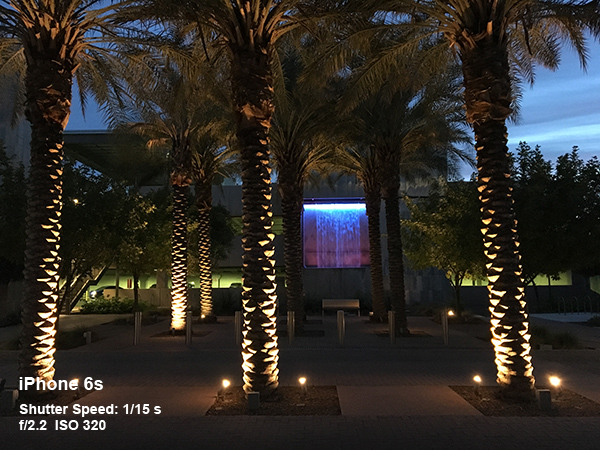
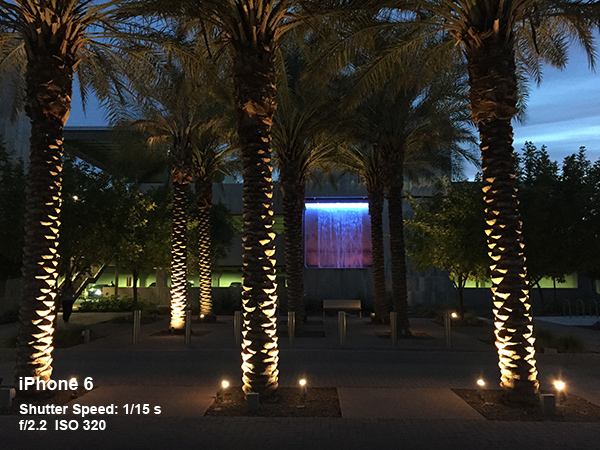
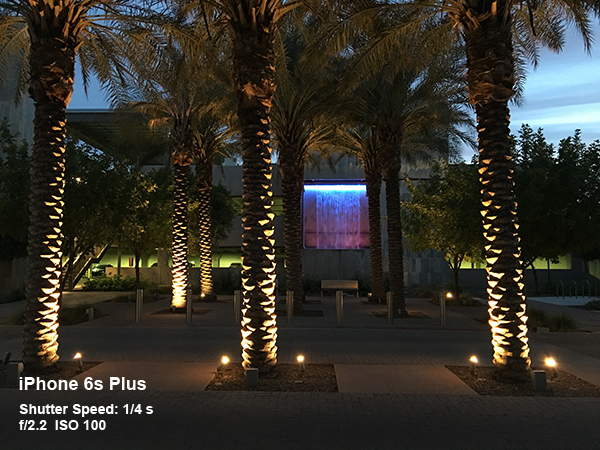



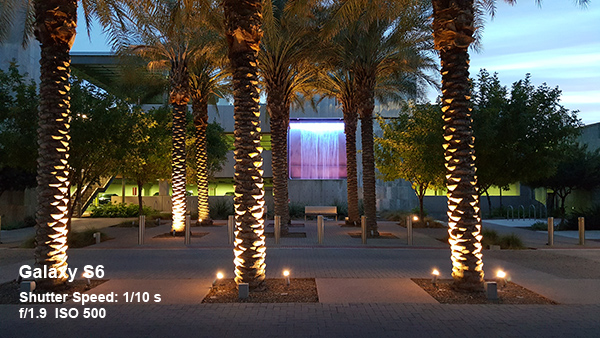




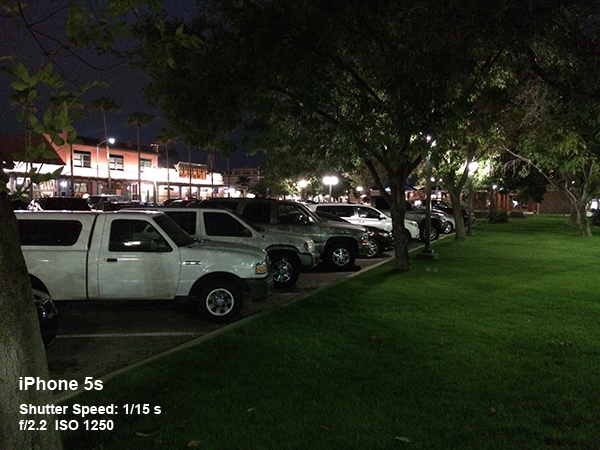

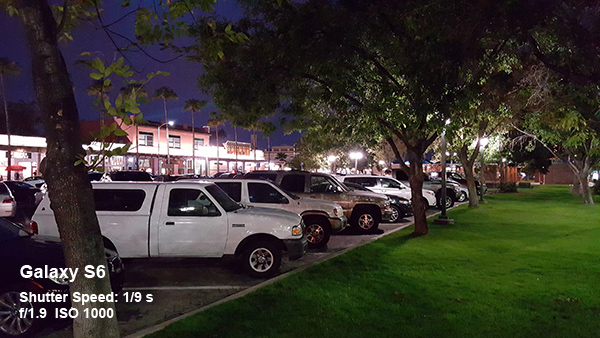
Full-Size Images: [iPhone 6s: night trees], [iPhone 6: night trees], [iPhone 6s Plus: night trees], [iPhone 6 Plus: night trees], [iPhone 5s: night trees], [LG G4: night trees], [Galaxy S6: night trees], [iPhone 6s: night parking lot], [iPhone 6: night parking lot], [iPhone 6s Plus: night parking lot], [iPhone 6 Plus: night parking lot], [iPhone 5s: night parking lot], [LG G4: night parking lot], [Galaxy S6: night parking lot]
The sun had just dipped below the horizon in the first set of images showing some palm trees and a waterfall, giving the cameras very little light to work with. In this situation, the LG G4 engages a special low-light mode with a longer exposure (notice how the waterfall looks more smeared), making the scene very bright—albeit unnaturally so—with everything clearly visible. All of the cameras with OIS make good use of it, holding their shutters open longer (33 percent for the G4 and S6 and 73 percent for the iPhone Plus models), allowing them to let in more light or, in the case of the iPhones, to decrease ISO and noise. While the iPhone images look dark, they do a good job of capturing how the scene actually looked. The Galaxy S6 takes the middle road, boosting brightness enough to easily see the scene but avoids the G4's unnatural appearance by not going too far.
Noise can severely degrade image quality in low-light situations. The Galaxy S6 manages to keep noise levels acceptably low, while still preserving a lot of detail; you can still see individual bricks on the ground and texture on the trees. Capturing more light with a longer exposure helps reduce noise in the G4's image. It also uses post-processing routines to smooth noise grain at the expense of fine detail. All of the cameras without OIS—iPhone 5s, iPhone 6, iPhone 6s—exhibit significantly more visible noise, which is most obvious in the image taken by the iPhone 6s, where more aggressive edge sharpening actually enhances the noise grain. Both of the iPhone Plus models perform better than the non-Plus models, with the 6s Plus showing a slight edge over the 6 Plus.
The second set of pictures of the parking lot were taken after dark. The cameras all choose their longest exposure setting again but raise ISO to compensate for the lower-light condition. Using its special low-light mode, the G4 takes the brightest image, overexposing the streetlights and bright lights on the building in the process. The Galaxy S6 image is not as bright as the G4, but it maintains a higher level of contrast with less haloing around light sources. Again, the iPhones produce darker images that more accurately reflect the actual luminance in the scene, with only minor differences between them. Whether you prefer the brighter images from the S6 and G4 or the more natural images from the iPhone is a matter of personal taste.
HDR
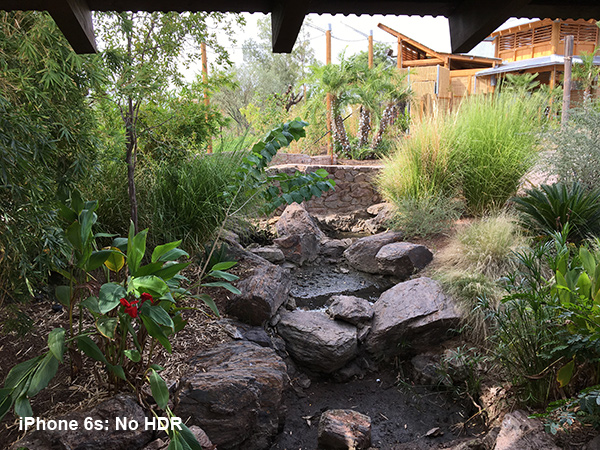


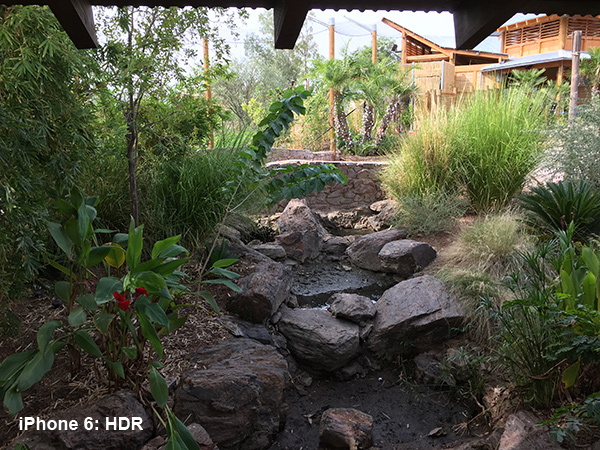






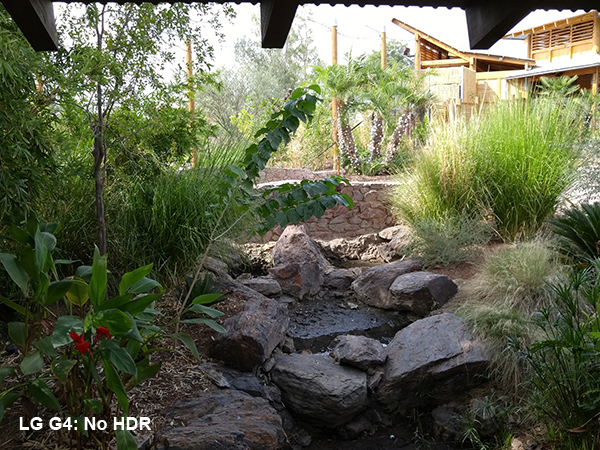

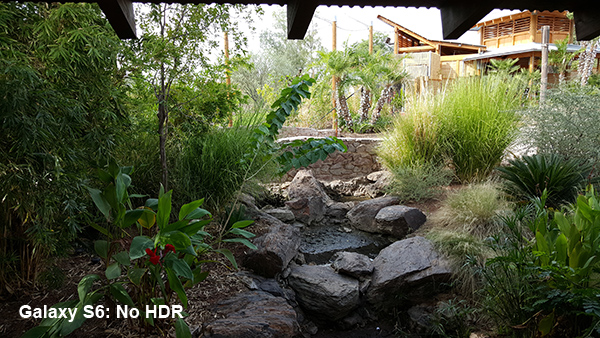

Full-Size Images: [iPhone 6s: stream - no HDR], [iPhone 6s: stream - HDR], [iPhone 6: stream - no HDR], [iPhone 6: stream - HDR], [iPhone 6s Plus: stream - no HDR], [iPhone 6s Plus: stream - HDR], [iPhone 6 Plus: stream - no HDR], [iPhone 6 Plus: stream - HDR], [iPhone 5s: stream - no HDR], [iPhone 5s: stream - HDR], [LG G4: stream - no HDR], [LG G4: stream - HDR], [Galaxy S6: stream - no HDR], [Galaxy S6: stream - HDR]
In the first set of HDR images, the Galaxy S6 does an excellent job brightening the shadows and reducing the glare on the roof in the background. The G4 also handles the shadows well, but basically ignores the brighter areas; the details of the netting are completely lost in the bright sky. Unfortunately, we see no improvement in HDR quality for the iPhone 6s, which continues to have the most conservative and underwhelming HDR mode of any flagship phone. All the iPhones do a nice job correcting the overexposed sky and reducing the glare on the roof, but instead of brightening the shadows they actually make the darker areas even darker. All of the HDR images show some purple fringing, a byproduct of the HDR processing, along edges bordering the sky; however, the Galaxy S6 also shows some additional purple spots amongst the leaves.
Before our trek across the African plains, we stopped by this watering hole filled with flamingos and snapped some more pictures. In this case, the G4 comes out on top by correcting both light and dark areas equally well without washing away too much color saturation. The Galaxy S6 also brightens up the shadows but leaves the sky and some of the flamingos standing in the hot sun overexposed. Its colors look good and noise is low, but there’s some loss of detail and color artifacts on the fence as well as some purple fringing around the flamingos, something the G4’s HDR algorithm avoids. The iPhones play it conservative again, reducing some of the glare but not lightening the shadows. There’s also some purple fringing, but it’s not as bad as in the G6 image.
With its new ISP and local tone mapping algorithm, we were certainly expecting more from the iPhone 6s' HDR mode. Instead its HDR images are no different than the iPhone 6's. The new ISP is fast, though, snapping HDR images with only about a one second delay.
Indoors
The staged indoor shots below were lit by overhead LED lights, a CFL lamp from the front, and an incandescent overhead light in the background.
Bright Light




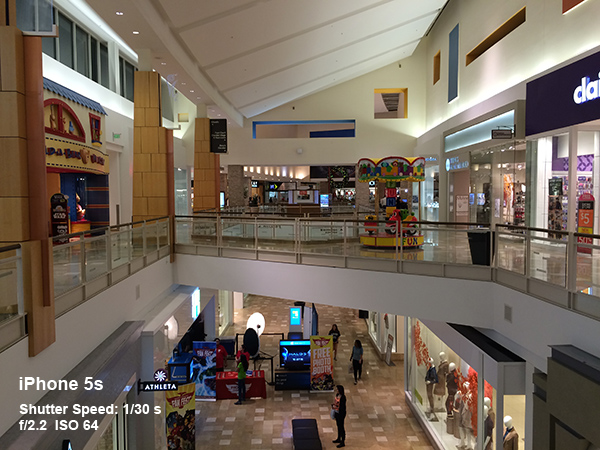


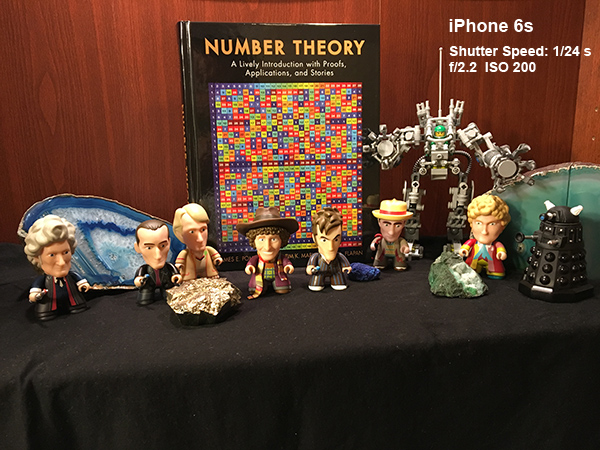






Full-Size Images: [iPhone 6s: indoor mall], [iPhone 6: indoor mall], [iPhone 6s Plus: indoor mall], [iPhone 6 Plus: indoor mall], [iPhone 5s: indoor mall], [LG G4: indoor mall], [Galaxy S6: indoor mall], [iPhone 6s: indoor bright], [iPhone 6: indoor bright], [iPhone 6s Plus: indoor bright], [iPhone 6 Plus: indoor bright], [iPhone 5s: indoor bright], [LG G4: indoor bright], [Galaxy S6: indoor bright]
Shooting pictures indoors without natural light makes setting white balance more challenging. Inside this shopping mall, all of the iPhones opt for a cooler tone, while the S6 and G4 are a little warmer. Overall the S6 produces the best looking image, with pleasing colors, minimal noise, good detail, and proper exposure.
Moving indoors does not elicit any new behavior from the iPhones; their images all still look about the same. Zooming in, both Plus models show a little less noise than the non-Plus versions, and both 6s models smooth noise grain a little better while maintaining better sharpness.
There's less light to work with in the second set of images, leading to more noise and more difficulty with white balance. The iPhone images have a reddish tint, the G4 image is a yellowish-green, and the S6 has a green tint. The iPhone 6 Plus and 6s Plus make better use of OIS to increase exposure and reduce ISO. In this scene, both the iPhone 6s and 6s Plus capture sharper images with less noise than the iPhone 6 and 6 Plus. The 6s Plus image has a bit less noise than the other iPhone images, putting it about on par with the Galaxy S6.
Low Light and Flash







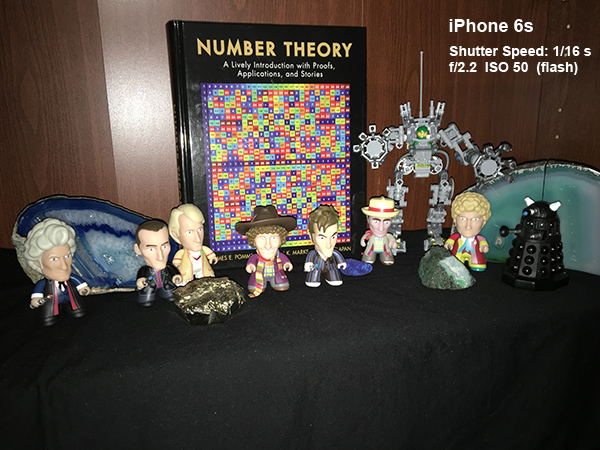





Full-Size Images:[iPhone 6s: indoor dark], [iPhone 6: indoor dark], [iPhone 6s Plus: indoor dark], [iPhone 6 Plus: indoor dark], [iPhone 5s: indoor dark], [LG G4: indoor dark], [Galaxy S6: indoor dark], [iPhone 6s: indoor flash], [iPhone 6: indoor flash], [iPhone 6 Plus: indoor flash], [iPhone 5s: indoor flash], [LG G4: indoor flash], [Galaxy S6: indoor flash]
Our lowest-light scene is lit only by an incandescent light in the background. The G4 struggles with white balance again, creating an image with an ugly yellow tint. However, the G4's noise reduction algorithm, which works better as light levels drop, does an excellent job wiping away noise while preserving image detail, including the numbers on the book and the thin lines on the figures’ clothing.
The iPhone 5s is the worst of the iPhones, its red-tinted image shows the most noise of any device in this roundup. The new 6s Plus pulls ahead of the other iPhones and is about on par with the Galaxy S6.
Front-Facing Camera


Full-Size Images: [iPhone 6s: front camera indoors], [iPhone 6s: front camera outdoors]
The iPhone's new front-facing FaceTime HD camera produces nice looking images. It usually does a good job setting white balance and exposure, although our outdoor example above should be a little brighter. Its extra pixels and less heavy-handed noise reduction processing give the iPhone 6s an edge in detail and sharpness over the iPhone 6, but noise grain is a bit more visible in the background with the new camera. The iPhone also does not seem to apply any automatic "beautification" processing to smooth skin wrinkles and blemishes like the Galaxy S6.
Additional Sample Images
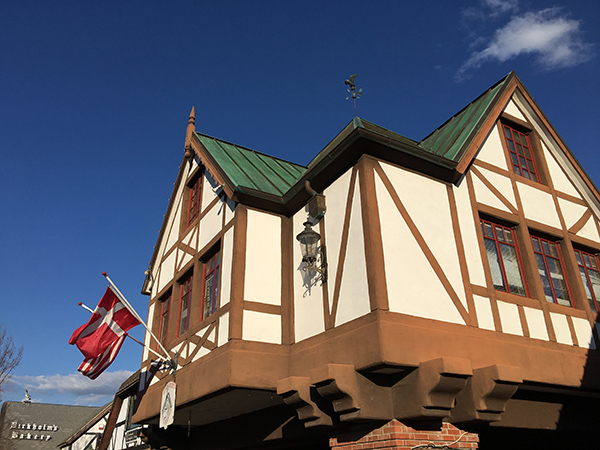



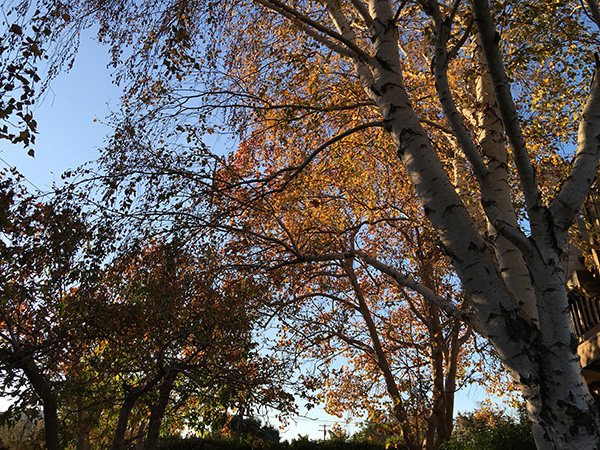







Full-Size Images: [iPhone 6s Plus: sample bakery], [iPhone 6s Plus: sample windmill], [iPhone 6s Plus: sample clock tower], [iPhone 6s Plus: sample flower bed], [iPhone 6s Plus: sample trees], [iPhone 6s Plus: sample tower], [iPhone 6s Plus: sample cafe], [iPhone 6s Plus: sample flowers], [iPhone 6s Plus: sample fall tree], [iPhone 6s Plus: sample desert 1], [iPhone 6s Plus: sample desert 2], [iPhone 6s Plus: sample desert 3]
After taking and comparing a lot of different photos, we cannot help but feel disappointed by the iPhone 6s' new iSight camera. In most situations, there's no perceivable difference in image quality between it and the iPhone 6 version. It's only in very low-light conditions where we see a small improvement in sharpness with less visible noise. Withholding OIS from the iPhone 6s hurts image quality, as its images consistently show more noise than those from the 6s Plus.
The Galaxy S6 still has the best camera, beating the iPhone 6s in every condition we tested. The 6s Plus manages to pull even with the S6 in some very low-light conditions, but still gets outperformed in most situations. We would place the iPhone 6s and 6s Plus above the LG G4, however, because of the G4's white balance issues and inconsistent noise reduction processing.
Current page: Camera Performance And Photo Quality
Prev Page Camera Features Next Page Apple A9 CPU And System Performance-
Shankovich I know lots of people are going to trash talk Apple here, but most of us know our hardware and thus should know a bit better. 2 gigs of ram seems low, but Apple's software is highly optimized and we know you can have a bunch of stuff open without it being that noticeable.Reply
Secondly, unless your eye ball touches the screen, you're not going to see a difference between a 1080p screen and above at typical viewing distances for a phone. (If you're going to complain about gaming on it, this site isn't for you). "So why don't they just put a higher res screen on it for the marketing aspect?" Well, aside from them being Apple, which is enough for most people, a higher res screen that most will barely be able to tell from FHD also means more work for the GPU, which means less battery life.
LG, Samsung, etc all do the same thing year over year, that being incremental upgrades, like Apple does. They're all the same. We've reached a saturation point in mobile devices now (probably did 2 years ago). -
10tacle What year is this? Why are we still seeing "new" so-called high end phones with 1080p 5.5" displays and 16GB base memory offerings? And for anyone who says that you can't really see the difference between 1080p and 1440p on such a small screen, get your eyes checked. Happy Samsung Note 5 owner here, upgrading from an 1136p, 326ppi iPhone 5S. (The Galaxy 6 and Note 5 are 1440p with 518ppi for anyone who cares).Reply -
monsta ummmmm don't you think you are just a bit late reviewing this phone that was released months ago ? LOLReply -
iam2thecrowe Seems ok if price isn't an object, most plans include the cost of the phone in a monthly payment now anyway. I will be getting one for work later this year, just hopefully battery life is much better than the 5s which is my current work phone. I wouldn't get one if I had to pay for it out of my own pocket though.Reply -
razor512 While I don't like the iphone, more companies need to follow their lead with the SOC. Instead of focusing on 8 slower cores (of which 4-6 of then remain idle most of the time since many tasks are not multithreaded. Focus on improving the IPC of the CPU and run newer but faster cores.Reply -
Astone3145 "QHD is only really necessary for AMOLED panels (due to having fewer red and blue subpixels than RGB stripe LCD panels), virtual reality applications (because the screen is closer to your eyes), and for people who augmented their genetic code with eagle DNA."Reply
I would love to have access to some of that augmented eagle DNA! -
MobileEditor ReplyI would love to have access to some of that augmented eagle DNA!
Do you struggle to see faraway objects? Find yourself squinting to read small text on your smartphone? Thanks to a breakthrough in genetic engineering, you can permanently upgrade your vision by augmenting your own blueprint with eagle DNA!
* See up to five times farther
* Experience more vivid colors
* See UV light
These are just a few of the advantages that await you after only a single, semi-painless treatment.
This treatment is not approved by the FDA. Some people may experience side effects, including upset stomach, loss of bone mass, accelerated growth of toenails, hardening of the lips, and nose bleeds. Please contact your doctor immediately if you feel the urge to jump from tall structures and soar above the trees, as this could indicate a potentially fatal condition. -
none12345 When your hardware is so far behind the competition its easy to make 70% gains lol. On one hand it's nice to see apple finally putting a little more hardware in their pones; on the other hand, flash is very cheap these days, and only 16 gigs is just downright laughable. The fact that put in like $5-15 more of ram and charge you $100-$300 is just a joke.Reply
And ya at minimum i would expect a 1080p screen, but really 1440p woudl be better. I dont know if phones need 4k in 5-6" just yet, at some point, sure. If you look at all the vr phone boxes coming out lately, you will absolutely notice a huge difference in screen res at a few inches from your eyes. Even 8k is not sufficient for that purpose.
In short tho, too little, too late, no thanks.

